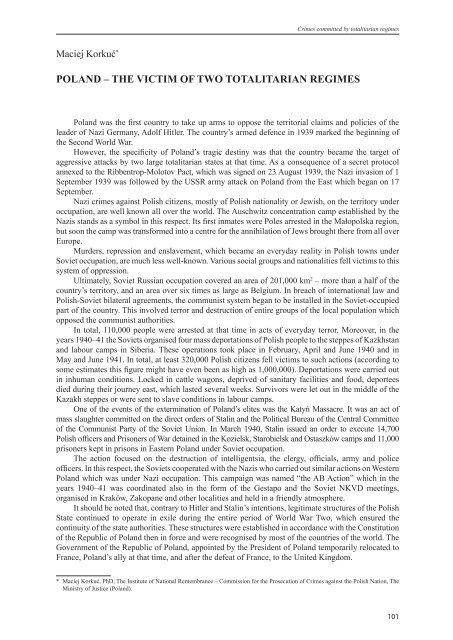crimes committed by totalitarian regimes - Ministrstvo za pravosodje
crimes committed by totalitarian regimes - Ministrstvo za pravosodje
crimes committed by totalitarian regimes - Ministrstvo za pravosodje
Create successful ePaper yourself
Turn your PDF publications into a flip-book with our unique Google optimized e-Paper software.
Crimes <strong>committed</strong> <strong>by</strong> <strong>totalitarian</strong> <strong>regimes</strong><br />
Maciej Korkuć *<br />
Poland – the victim of two <strong>totalitarian</strong> <strong>regimes</strong><br />
1<br />
Poland was the first country to take up arms to oppose the territorial claims and policies of the<br />
leader of Nazi Germany, Adolf Hitler. The country’s armed defence in 1939 marked the beginning of<br />
the Second World War.<br />
However, the specificity of Poland’s tragic destiny was that the country became the target of<br />
aggressive attacks <strong>by</strong> two large <strong>totalitarian</strong> states at that time. As a consequence of a secret protocol<br />
annexed to the Ribbentrop-Molotov Pact, which was signed on 23 August 1939, the Nazi invasion of 1<br />
September 1939 was followed <strong>by</strong> the USSR army attack on Poland from the East which began on 17<br />
September.<br />
Nazi <strong>crimes</strong> against Polish citizens, mostly of Polish nationality or Jewish, on the territory under<br />
occupation, are well known all over the world. The Auschwitz concentration camp established <strong>by</strong> the<br />
Nazis stands as a symbol in this respect. Its first inmates were Poles arrested in the Małopolska region,<br />
but soon the camp was transformed into a centre for the annihilation of Jews brought there from all over<br />
Europe.<br />
Murders, repression and enslavement, which became an everyday reality in Polish towns under<br />
Soviet occupation, are much less well-known. Various social groups and nationalities fell victims to this<br />
system of oppression.<br />
Ultimately, Soviet Russian occupation covered an area of 201,000 km 2 – more than a half of the<br />
country’s territory, and an area over six times as large as Belgium. In breach of international law and<br />
Polish-Soviet bilateral agreements, the communist system began to be installed in the Soviet-occupied<br />
part of the country. This involved terror and destruction of entire groups of the local population which<br />
opposed the communist authorities.<br />
In total, 110,000 people were arrested at that time in acts of everyday terror. Moreover, in the<br />
years 1940–41 the Soviets organised four mass deportations of Polish people to the steppes of Kazkhstan<br />
and labour camps in Siberia. These operations took place in February, April and June 1940 and in<br />
May and June 1941. In total, at least 320,000 Polish citizens fell victims to such actions (according to<br />
some estimates this figure might have even been as high as 1,000,000). Deportations were carried out<br />
in inhuman conditions. Locked in cattle wagons, deprived of sanitary facilities and food, deportees<br />
died during their journey east, which lasted several weeks. Survivors were let out in the middle of the<br />
Ka<strong>za</strong>kh steppes or were sent to slave conditions in labour camps.<br />
One of the events of the extermination of Poland’s elites was the Katyń Massacre. It was an act of<br />
mass slaughter <strong>committed</strong> on the direct orders of Stalin and the Political Bureau of the Central Committee<br />
of the Communist Party of the Soviet Union. In March 1940, Stalin issued an order to execute 14,700<br />
Polish officers and Prisoners of War detained in the Kozielsk, Starobielsk and Ostaszków camps and 11,000<br />
prisoners kept in prisons in Eastern Poland under Soviet occupation.<br />
The action focused on the destruction of intelligentsia, the clergy, officials, army and police<br />
officers. In this respect, the Soviets cooperated with the Nazis who carried out similar actions on Western<br />
Poland which was under Nazi occupation. This campaign was named “the AB Action” which in the<br />
years 1940–41 was coordinated also in the form of the Gestapo and the Soviet NKVD meetings,<br />
organised in Kraków, Zakopane and other localities and held in a friendly atmosphere.<br />
It should be noted that, contrary to Hitler and Stalin’s intentions, legitimate structures of the Polish<br />
State continued to operate in exile during the entire period of World War Two, which ensured the<br />
continuity of the state authorities. These structures were established in accordance with the Constitution<br />
of the Republic of Poland then in force and were recognised <strong>by</strong> most of the countries of the world. The<br />
Government of the Republic of Poland, appointed <strong>by</strong> the President of Poland temporarily relocated to<br />
France, Poland’s ally at that time, and after the defeat of France, to the United Kingdom.<br />
* Maciej Korkuć, PhD, The Institute of National Remembrance – Commission for the Prosecution of Crimes against the Polish Nation, The<br />
Ministry of Justice (Poland).<br />
101




